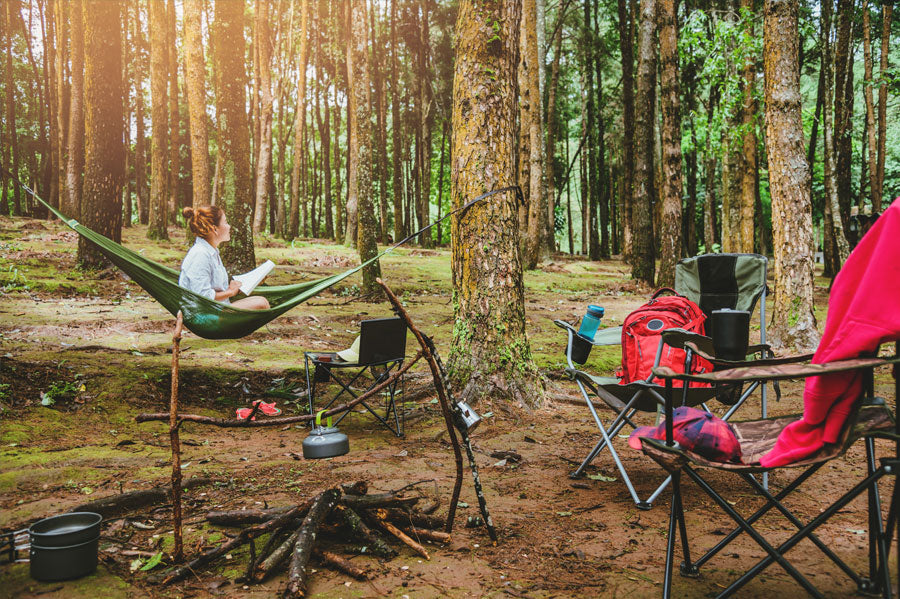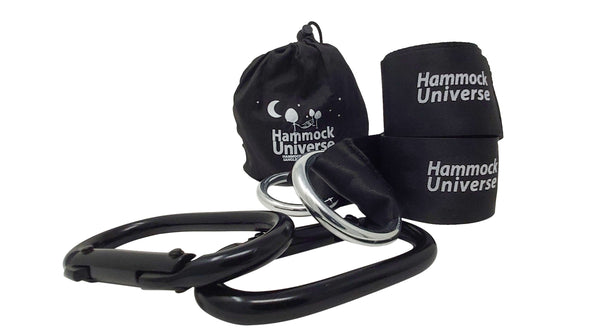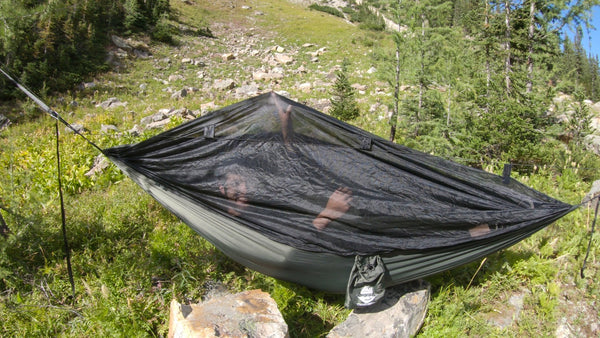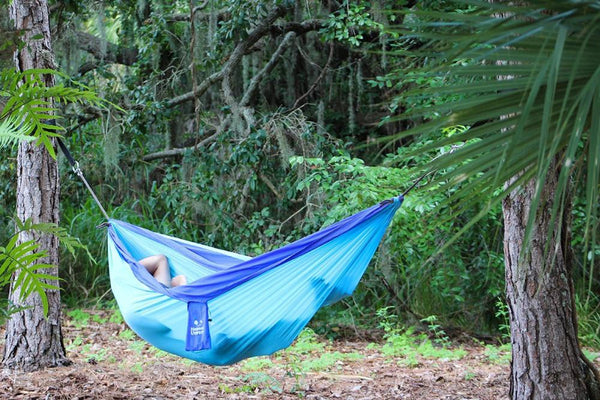FREE SHIPPING on most orders $25+ HAMMOCK BUYING GUIDE
Menu
-
-
Hammocks
-
Hammock Stands
-
Hammocks with Stands
-
Hanging Hammock Chairs
- View all Hammock Chairs
- Brazilian Style Hammock Chairs
- Colombian Hammock Chairs
- Mayan Hammock Chairs
- Mayan Hammock Chairs Deluxe
- Universal Hammock Chair Stand
- U Hammock Chair Stand
- Brazilian Hammock Chair with Universal Chair Stand
- Colombian Hammock Chair with Universal Chair Stand
- Mayan Hammock Chair with Universal Chair Stand
- Mayan Hammock Chair Deluxe with Universal Stand
-
Accessories
- Gift Cards
- Tools and Guides
- Bargain Bin
-
- 1-800-207-4761
- Login

FREE SHIPPING on most orders $25+ HAMMOCK BUYING GUIDE
Eco-Friendly Camping: Minimizing Your Impact on the Environment
March 10, 2023 6 min read

Camping is a great way to get away from the hustle and bustle of everyday life and connect with nature.
However, as more people take to the great outdoors, it's important to be mindful of our impact on the environment. Fortunately, there are many simple steps we can take to minimize our impact and enjoy eco-friendly camping. From choosing sustainable gear to practicing Leave No Trace principles, there are many ways to reduce our impact on the environment while still enjoying all the benefits of camping.
We're exploring some of the best ways to minimize your impact on the environment while camping, so you can appreciate nature while protecting it!
Leave No Trace Principles
Are you an avid camper and wanting to minimize your environmental impact on your next trip?
Look no further than the Leave No Trace principles. These seven principles provide a set of guidelines for enjoying the great outdoors while preserving the environment for future generations to come.
Starting off with the first one - plan ahead and prepare. This involves researching the area you will be camping in, and familiarizing yourself with any regulations or guidelines specific to that location. Proper preparation also includes bringing enough food and water for your trip, as well as appropriate gear to keep you safe and comfortable.
Next up is the second principle, travel and camp on durable surfaces. This means avoiding trampling on fragile plant life or setting up camp on delicate terrain. Instead, stick to established campsites and trails, and use established fire rings when building a fire.
Another important LNT principle is number three, disposing of waste properly. This includes packing out all trash and litter, and properly disposing of human waste. Bringing along a small shovel can be helpful in properly disposing of waste and avoiding contamination of water sources.
By following these principles and other Leave No Trace guidelines, you can enjoy the beauty of nature while minimizing your impact on the environment.
Choosing Eco-Friendly Camping Gear
How to Choose Sustainable and Environmentally Friendly Gear
When it comes to choosing sustainable and environmentally friendly gear for your camping trip, there are a few things to consider.
First, look for gear that is made from sustainable or recycled materials. Many outdoor companies now offer products made from recycled plastic bottles, fishing nets, and other sustainable materials. Some camping gear is made from natural materials like bamboo, hemp, or organic cotton, which are more eco-friendly than synthetic alternatives.
If you want to go the extra mile, consider buying from companies that prioritize sustainability and ethical practices in their manufacturing process.
Next, choose gear that is durable and long-lasting. Single-use or disposable items not only create more waste but also require more resources to produce. Investing in quality, long-lasting gear can save you money in the long run and reduce your impact on the environment.
Pro tip: Consider repairing gear instead of replacing it when possible!
And last but not least, you should think about the energy consumption of your gear. Opt for solar-powered lanterns and chargers instead of those that require batteries or other non-renewable energy sources. Use rechargeable batteries and invest in a portable solar panel to charge them.
Every small step towards sustainability counts in reducing our impact on the environment!
The Benefits of Using Eco-Friendly Gear
Choosing eco-friendly camping gear can have many benefits for the environment, as well as for you as a camper.
By reducing your environmental impact, you are helping to preserve natural resources and protect the ecosystems that you are exploring. Using durable and long-lasting gear can save you money in the long run, while solar-powered gear can help you stay connected while minimizing your carbon footprint.
Minimizing Waste While Camping
By minimizing waste and disposing of it properly, you can contribute towards preserving the natural world and safeguarding its uniqueness.
Tips for Reducing Waste
Minizmizing your waste while camping is easy--when you've got the right tips! We've put together some pointers for campers to make sure their waste can be minimized and safe while camping:
- Plan your meals and pack only what you need
- Use refillable water bottles and avoid buying bottled water
- Bring a cloth towel instead of paper towels
- Compost food waste if possible
- Bring reusable bags for shopping and packing
- Use a portable camping stove instead of disposable firewoo
How To Properly Dispose of Trash and Waste
Properly disposing of trash and waste is crucial to minimizing your impact on the environment while camping.
Always pack out all of your trash and bring it with you when you leave. Never burn or bury trash, as it can harm the environment and wildlife. Human waste should be buried at least 6 inches deep and at least 200 feet away from water sources, while gray water should be disposed of at least 200 feet away from any water source.
Conserving Resources
Conserving resources is another important aspect of eco-friendly camping. Always turn off lights and electronics when not in use, and consider using solar-powered devices.
Minimizing Water Usage and Reducing Energy
Minimizing water usage and reducing energy are key ways to make your camping trip more eco-friendly.
When it comes to water, avoid leaving taps running and take shorter showers to conserve water. You can also collect rainwater or use a water filter to access natural water sources instead of relying on bottled water.
You can also opt to use energy-efficient camping gear, such as LED lanterns, which use less energy and last longer than traditional bulbs. You can also use rechargeable batteries and solar-powered devices to reduce your reliance on fossil fuels.
Reducing your water usage and energy consumption helps you protect the environment while enjoying the great outdoors. That's a win-win!
Setting Up Your Hammock
Speaking of the great outdoors, there's nothing like arriving at your camping destination and kicking back in your hammock. Setting up a hammock is a great way to relax and enjoy nature, but it's important to do so responsibly to minimize your impact on the environment.
First, make sure you are allowed to hang your hammock in the area you've chosen. Some parks and campsites have specific rules about where and how to hang your hammock.
Step two is to choose a sturdy and healthy tree, at least 6 inches in diameter, to hang your hammock from. If you're not sure about the measurements, then using a hammock hanging calculator can be a lifesaver. Avoid tying your hammock to trees with loose bark, as it can damage the tree.
Make sure to pack out any trash or items you bring with you and leave the area as you found it.
Tips for Choosing an Eco Friendly Campsite
Choosing an eco-friendly campsite is an important step towards making your camping trip is a eco-friendly as can be.
Look for campsites that follow sustainable practices, such as using renewable energy, composting, and using environmentally friendly cleaning products. You can also consider campsites with recycling programs and waste reduction initiatives. You can also choose campsites that are accessible by public transportation or offer alternative transportation options to reduce your carbon footprint.
When choosing a campsite, avoid areas with delicate ecosystems or high-risk wildfire areas. It's also important to follow any rules or regulations in the area, such as fire bans and animal protection measures.
Eco-Friendly Campsite Practices
Once you've found your eco-friendly campsite, there are several practices you can adopt to minimize your impact on the environment while camping.
Use biodegradable soap and cleaning products, and avoid using chemical insect repellents and sprays. Instead, use natural alternatives, such as citronella candles or essential oils. When cooking, use a camp stove instead of an open fire to reduce the risk of wildfires and minimize air pollution.
Pack reusable water bottles, utensils, and containers instead of disposable options to reduce waste. Finally, be respectful of wildlife and natural resources, and avoid damaging or disturbing plant life and habitats.
Why You Must Leave the Campsite Better Than You Found It
Leaving your campsite clean and tidy helps ensure that future campers can enjoy the area as much as you did. Remember, the goal of eco-friendly camping is to leave a positive impact on the environment, not a negative one, so take the time to properly cleanup before leaving your campsite.
The Takeaway
Eco-friendly camping is not only a responsible way to enjoy the great outdoors, but it also helps to protect and preserve our earth.
By following simple habits like practicing Leave No Trace principles, choosing eco-friendly gear, minimizing waste, and conserving resources, we can all reduce our impact on the natural world.
By sharing these practices with others, we can encourage a culture of responsible camping and help ensure that our natural resources are protected for future generations.
So the next time you plan a camping trip, take a moment to think about how you can make your experience more eco-friendly, and enjoy the peace of mind that comes from knowing you're doing your part to protect the environment.
Hammock Universe is your one stop shop for eco-friendly hammocks and straps to make sure you camping trip is both memorable and safe. Contact us today!
Related Products
Want to relax?
Join for exclusive content and promotions we only give to our email list!


